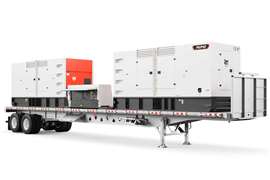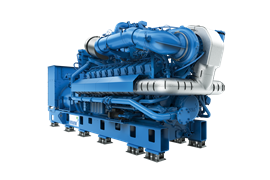Yanmar aims to commercialize marine fuel cell system in 2023
27 May 2022
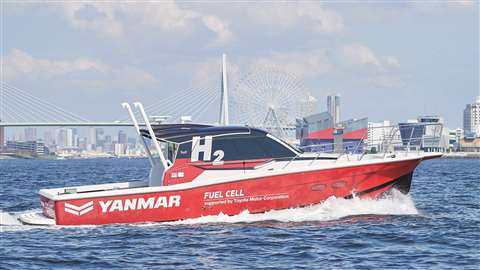 Yanmar has developed and tested a fuel cell propulsion system for marine applications. (Photo: Yanmar)
Yanmar has developed and tested a fuel cell propulsion system for marine applications. (Photo: Yanmar)
The push toward reduction of greenhouse gas (GHG) emissions toward carbon neutrality not only crosses national and regional borders, but also reaches across virtually every segment that utilizes engine power.
In the marine sector, the International Maritime Organization (IMO) first adopted a GHG reduction strategy in 2018. IMO aims to achieve zero emissions from international marine transportation as early as possible this century, as well as to improve emissions per unit of transport by at least 40% by 2030 and reduce total GHG emissions by at least 50% by 2050, both compared to 2008 levels. More recently, there have been discussions about advancing the schedule and at the same time, there are movements toward reducing NOx emissions in ports, especially in Europe and the U.S.
In an effort to bring zero-emissions technology to marine propulsion applications, Yanmar has developed hydrogen fuel cell technology for marine vessels and has conducted demonstration tests of a fuel cell-powered boat and shore-to-ship hydrogen refueling procedures.
Government support
Much of Yanmar’s efforts have been as part of projects funded by Japan’s Ministry of Land, Infrastructure, Transport and Tourism (MLIT) and Ministry of the Environment (MoE).
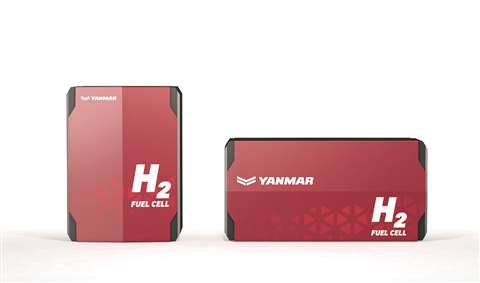 Yanmar said it aims to have a 300-kW class marine fuel cell system commercialized by 2023. (Photo: Yanmar)
Yanmar said it aims to have a 300-kW class marine fuel cell system commercialized by 2023. (Photo: Yanmar)
“From 2015 to 2017, Yanmar joined a project to research the development of ‘Safety Guidelines for Hydrogen Fuel Cell Ships,’” said Takehiro Maruyama, member of the New Power Source Group at Yanmar, who has been a project leader for the development of marine fuel cell systems since 2018. “Then we joined a project to develop a ‘Roadmap for Deployment of Hydrogen Fuels Cell for Maritime Applications’ funded by the Ministry of the Environment.
“Building on these experiences, we started a project to develop and test a maritime hydrogen fuel cell system on a test boat in 2019, using components from a Toyota Mirai fuel cell vehicle.”
Takuya Hiraiwa, of the System Engineering Division of Yanmar Power Technology, noted that “since it was the first project to consider this kind of guideline, the project team struggled to find a way forward.
“For example, there were questions like, what happens if a hydrogen fuel cell is immersed in seawater? What happens if the ship is rocking and tilting? What if there’s a hydrogen leakage? The project team investigated these questions with component tests in the lab as well as field tests.”
Whole new boat
To consider all of the safety elements as well as the requirements for fuel cell installations in vessels, Yanmar concluded an actual working vessel that could be used for testing was necessary.
“To build a demonstration test boat, we almost had to develop a whole new boat,” Maruyama said. “We had to develop an electric powertrain that included not only the fuel cell system but also other components, such as lithium-ion batteries and a motor as well as the power management software.
“We also had to design a new hull and the boat required a special hydrogen refueling facility.”
Since the initial project members could not handle all the requirements themselves, Yanmar solicited outside companies for support. “Some were initially hesitant to cooperate with us,” Maruyama said, “so we repeatedly explained the significance of this demonstration test and our vision for the future.
“Eventually, we were able to secure many collaborations both within the Yanmar Group as well as with external partners such as Toyota Motor Corp., Iwatani Corp., Toyota Tsusho Corp. and many other companies, while government agencies such as MLIT and Osaka Prefectural Government also supported the project.”
Hull design challenge
A significant early design challenge was developing a hull design that could house all of the hydrogen fuel cell systems and balance of plant, while meeting the safety design requirements of MLIT and the Japan Craft Inspection Organization (JCI). The task of hull design was assumed by Yukihiko Kimura, part of Yanmar Marine International Asia.
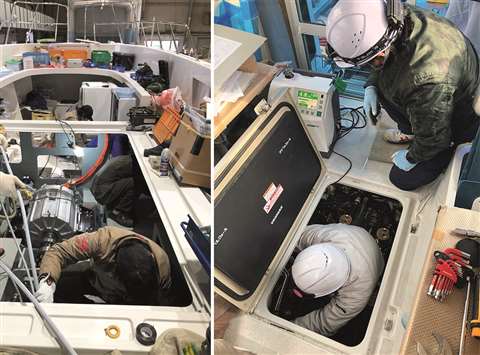 A significant challenge involved packaging of the fuel cell system and balance of plant within the vessel’s hull spaces. (Photo: Yanmar)
A significant challenge involved packaging of the fuel cell system and balance of plant within the vessel’s hull spaces. (Photo: Yanmar)
“The components of the powertrain for propulsion are quite different from the conventional diesel engine-powered boats, which are designed in matured and standardized processes,” Kimura said. “In the case of the fuel cell demonstration boat, there were many components that had to be installed and work together, such as fuel cell systems, motors, inverters, power distribution boxes, battery packs and hydrogen tanks, etc.
“There was no standardized process to design fuel cell-powered boats, but even so, we had to ensure the safety of the boat in any operating conditions in the field.
“In practice, we found some of the requirements in the guidelines were not realistic for this type of boat. It was quite difficult to find space to install the eight hydrogen tanks. The guidelines require a certain clearance from the side and bottom wall of the boat to ensure that the tanks are not damaged in case of collision or stranding. In such cases, we proposed alternative designs to ensure the same level of safety as that required in the guideline.”
Under the deck
Hiraiwa, who led the coordination efforts with MILT and JCI, said, “In the end, all the components were properly installed under the deck. The construction proceeded from scratch – there was no precedent. It was not at all like making improvements to a conventional diesel engine-powered boat.”
Despite complications caused by the COVID-19 pandemic and the fact that the hull and components were designed in different places in Japan (with no travel allowed between them), the construction of the test boat was completed in early 2021. The vessel received approval from JCI and demonstration tests commenced in March 2021.
Initial test runs focused on adjustments of the electric powertrain control software and the performance of the hydrogen fuel cell system under actual navigation conditions. Last fall, the test boat was moved to Osaka Bay, where it was refueled with a 70-MPa high-pressure hydrogen refueling station, said to be the first of its kind for the specific marine application class.
The boat ran a route connecting the planned site of the Osaka-Kansai Expo with tourist spots along the city’s coast.
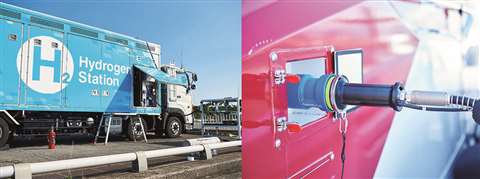 During testing in Osaka Bay, the fuel cell demonstration boat was refueled with a 70 MPa high-pressure hydrogen refueling station, said to be the first of its kind for the specific marine application class. (Photo: Yanmar)
During testing in Osaka Bay, the fuel cell demonstration boat was refueled with a 70 MPa high-pressure hydrogen refueling station, said to be the first of its kind for the specific marine application class. (Photo: Yanmar)
“The demonstration boat is so quiet that we can hear the natural sounds of the ocean,” said Kimura. “It’s something you can’t experience when you’re on a diesel engine-powered boat.
“From a boat building, navigation and service perspective, since the boat contains many components that are not installed in diesel engine-powered boats, and the actual weight of the boat is heavier, we need to start thinking about how we can make the fuel cell systems and components lighter and more compact.”
Maruyama said the results of these tests will be utilized in the future development of maritime hydrogen fuel cell system products and the investigation of hydrogen refueling infrastructure for ships. A side benefit, he added, was a media event that “had an amazing response from all over the world.”
“Compared to just desktop studies, we learned a lot by building the demonstration boat and testing it,” Hiraiwa said. “In addition, through our media activities, we have been contacted not only by potential customers but also by various hydrogen and marine organizations in Japan and overseas.
“I realized the impact of actually getting the demonstration done, and feel that we have actually enhanced our capabilities and gained a lot of experience through the process of design, construction and demonstration testing.”
What’s ahead
While Yanmar’s aim is to commercialize a 300-kW class marine fuel cell system next year and deploy it at the Osaka-Kansai Expo and other carbon neutral ports in 2025, the company sees opportunities for the technology well beyond the waves.
“In our business fields, the first step is to commercialize the maritime hydrogen fuel cell system,” Maruyama said. “We think we can expand the technology and business to land applications such as generator sets.”
Hiraiwa added, “I believe that our mission is to develop powertrain systems that combine hydrogen fuel cell systems and hydrogen engines, etc., and to bring them to global markets.”
POWER SOURCING GUIDE
The trusted reference and buyer’s guide for 83 years
The original “desktop search engine,” guiding nearly 10,000 users in more than 90 countries it is the primary reference for specifications and details on all the components that go into engine systems.
Visit Now
STAY CONNECTED




Receive the information you need when you need it through our world-leading magazines, newsletters and daily briefings.
CONNECT WITH THE TEAM










